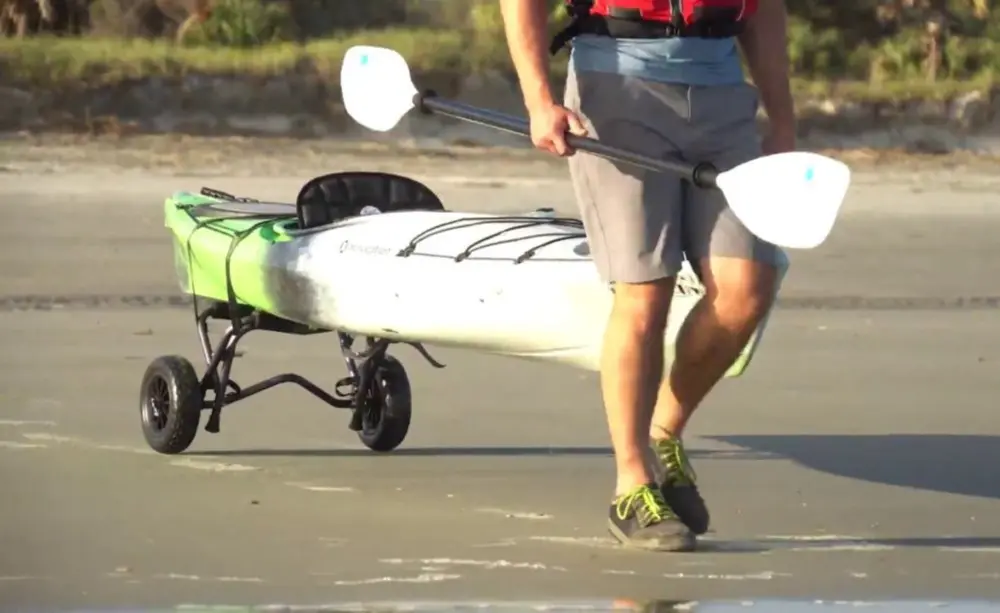Types of Wheels
Kayak cart wheels come in a variety of compositions, sizes, and tread patterns to suit different needs. Common options include:
Pneumatic Wheels
Pneumatic wheels contain inner tubes similar to bicycle tires. They provide great shock absorption on uneven ground but are vulnerable to punctures. Pneumatic wheels tend to be best for long distances on relatively smooth surfaces.
Solid Wheels
Molded from rubber or plastic as one solid piece, these durable wheels withstand rugged terrain without risk of deflation. However, they don’t cushion as well on bumps. Solid wheels work well for rocky beaches and wooded trails.
Foam-Filled
Combining pneumatic tire casings with foam interiors, these hybrid wheels offer puncture resistance along with some shock absorption. They strike a nice balance for mixed-condition hauling.
Treads
Lug patterns on kayak cart wheels provide traction, much like tire treads. Deep treads excel on loose dirt, gravel, or sand. Shallower treads better suit hard surfaces like concrete or pavement.
Wheel Size
Standard kayak cart wheel diameters range from about 8” on smaller carts up to around 13” on heavier-duty models. Larger wheels easily roll over obstacles like rocks, roots, or dips. But smaller wheels may be more portable and maneuverable for storage or navigating tight spaces.
Durability and Maintenance
Kayak cart wheels endure a lot of wear and tear. It’s important to periodically check them for signs of damage or excessive tread wear. Replacing wheels at the first signs of cracking, rot, or deformation helps prevent failures out on the trail.
Rinsing or wiping wheels after salty or muddy trips removes corrosive grime. Storing the cart out of direct sunlight also preserves wheel integrity and elasticity. Carrying a spare inner tube and patch kit provides insurance against flats.
Performance Factors
The materials and tread design enable different cart wheels to shine on certain terrain:
Grass: Wide, lugged pneumatic tires excel on lawn, meadows, or field portages.
Gravel: Solid rubber tires withstand loose rocks well, while deeper air-filled treads provide cushion.
Sand: Again, wide solid wheels work best here, with more surface area to stay atop the shifting substrate.
Pavement: Narrower wheels with minimal tread smoothly roll long distances on concrete or asphalt.
Mud: Knobby air-filled tires combined with wide stance prevent sinking in mucky launches.
Water: Special amphibious wheels feature built-in flotation and waterproof hubs to ford streams or wet beaches.
Stability and Design
A kayak cart’s wheel placement plays a big role in stability. Wider axle spacing provides a more stable base to prevent tipping. Longer wheelbases similarly lower the center of gravity.
Swivel wheels that pivot freely aid maneuverability around tight corners. Dual-arm support bars also grant adaptability on uneven terrain.
For larger kayaks, choose a cart with sufficient weight capacity and wider cradle width to safely bear the load. High-strength yet lightweight aluminum or stainless steel frames withstand corrosion.
Accessorizing Your Kayak Cart Wheels
You can customize carts with accessories like:
All-Terrain Wheels: Special rugged treads for conquering nearly any portage conditions
Balloon Wheels: Extra-large air tires for floating over obstacles
Replacement Wheels: Keep spares on hand for repairs and upgrades
Wheel Fenders: Prevent splash from covering wheels and frame
When selecting kayak cart wheels, factor in your boat’s size, the average transport distance, storage considerations, and of course terrain. While wheels may not be flashy, they directly impact performance. Investing in quality wheels tailored to your paddling style ensures smooth, safe passages to the water for years of happy trails!
Edited: Dec 13, by Adminai
